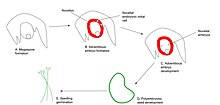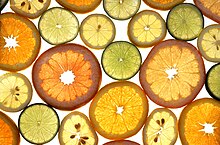Nucellar embryony


Nucellar embryony (notated Nu+) is a form of seed reproduction that occurs in certain plant species, including many citrus varieties. Nucellar embryony is a type of apomixis, where eventually nucellar embryos from the nucellus tissue of the ovule are formed, independent of meiosis and sexual reproduction.[1] During the development of seeds in plants that possess this genetic trait, the nucellus tissue which surrounds the megagametophyte can produce nucellar cells, also termed initial cells. These additional embryos (polyembryony) are genetically identical to the parent plant, rendering them as clones. By contrast, zygotic seedlings are sexually produced and inherit genetic material from both parents. Most angiosperms reproduce sexually through double fertilization. Different from nucellar embryony, double fertilization occurs via the syngamy of sperm and egg cells, producing a triploid endosperm and a diploid zygotic embryo. In nucellar embryony, embryos are formed asexually from the nucellus tissue. Zygotic and nucellar embryos can occur in the same seed (monoembryony), and a zygotic embryo can divide to produce multiple embryos.[2] The nucellar embryonic initial cells form, divide, and expand. Once the zygotic embryo becomes dominant, the initial cells stop dividing and expanding. Following this stage, the zygotic embryo continues to develop and the initial cells continue to develop as well, forming nucellar embryos. The nucellar embryos generally end up outcompeting the zygotic embryo, rending the zygotic embryo dormant. The polyembryonic seed is then formed by the many adventitious embryos within the ovule[3] (to picture this process, refer to Figure 1). The nucellar embryos produced via apomixis inherit its mother's genetics, making them desirable for citrus propagation, research, and breeding.[4]
Nucellar embryony outside of citrus varieties[edit]
Nucellar embryos have also been found in polyembryonic Mango varieties, where generally one of the embryos is zygotic and the rest are nucellar.[5] However, there is little research on Mangos undergoing nucellar embryo development as there has on varieties of citrus.
Conditions[edit]
Nucellar embryony is able to occur within both fertilized and unfertilized ovules. Furthermore, instead of using the endosperm as nutritive tissue, it will utilize the surrounding nucellus tissue for nutrition.[3] For example, the ‘Valencia’ orange undergoes nucellar embryony in both fertilized and unfertilized conditions.[3] But, it has been found that nucellar embryo development, under fertilized or unfertilized conditions, can take place in different positions.[6]
Features[edit]
An important component of nucellar embryo development is its changing cell wall thickness. Between nucellar embryo's initial cell stage and its dividing and expanding stage, the cells' wall thickens.[7] This most likely occurs due to callose deposition; callose deposition reduces the permeability of a cell and is usually found in the initial cells about to undergo embryogenesis.[8] The initial cells become enlarged, rounded, and divided. During this stage, the initial cell's cell walls thin out, leaving room for the nucleus to become distinguished.
Seedless fruits and influence by the citrus industry[edit]
Many seed plants, including citrus fruits, are self-compatible, meaning that they are able to fertilize themselves. Self-compatibility produces a seedy fruit which may be deemed as undesirable to the citrus industry.
Seedless fruits have been made popular as they are sought-after in the citrus industry. To be seedless, a citrus must exhibit self-incompatibility, another reproductive trait within citrus fruits and many seed plants. Self incompatibility is the phenomena where hermaphroditic plants are not able to produce fertile embryos after self-pollination.[9] Self-incompatibility is regulated by the S-loci; if pollen is rendered incompatible, it is determined by its haploid S genotype, or if its sporophyte is rendered incompatible, it would be determined by its diploid S genotype. This is also termed and associated with parthenocarpy, the production of fruit without fertilization. Self-incompatible fruits are able to undergo parthenocarpy to yield seedless fruits. In citrus specifically, there have been other modes developed to reduce seeding as well: gibberellic acid enhances ovule abortion[10] and copper sulfate has been shown to reduce seed number in fruit.[11] An example is the ‘Afourer’ mandarin that contains a haploid self-incompatibility system and parthenocarpy. Under conditions where cross-pollination is not present, the ‘Afourer’ mandarin produces a seedless fruit by undergoing parthenocarpy. Where cross-pollination is present, gibberellic acid is applied and produces a decreased seeding fruit.[11]
Nucellar embryony is important to the citrus industry, as it allows for the production of uniform rootstock which yields consistent results in fruit production. However, this trait can interfere with progress in cross-breeding; most commercial scion varieties produce mainly nucellar seedlings which do not inherit any of the traits of the "father" plant.
See also[edit]
References[edit]
- ^ a b Zhang, Siqi; Liang, Mei; Wang, Nan; Xu, Qiang; Deng, Xiuxin; Chai, Lijun (March 2018). "Reproduction in woody perennial Citrus: an update on nucellar embryony and self-incompatibility". Plant Reproduction. 31 (1): 43–57. doi:10.1007/s00497-018-0327-4. ISSN 2194-7953. PMID 29457194. S2CID 254022638.
- ^ Aleza, P.; Juárez, J.; Ollitrault, P.; Navarro, L. (2010). "Polyembryony in non-apomictic citrus genotypes". Annals of Botany. 106 (4): 533–545. doi:10.1093/aob/mcq148. PMC 2944972. PMID 20675656.
- ^ a b c Koltunow, A. M. (1993-10-01). "Apomixis: Embryo Sacs and Embryos Formed without Meiosis or Fertilization in Ovules". The Plant Cell. 5 (10): 1425–1437. doi:10.1105/tpc.5.10.1425. ISSN 1040-4651. PMC 160373. PMID 12271038.
- ^ Spillane, C.; Steimer, A.; Grossniklaus, U. (2001-12-01). "Apomixis in agriculture: the quest for clonal seeds". Sexual Plant Reproduction. 14 (4): 179–187. doi:10.1007/s00497-001-0117-1. ISSN 1432-2145. PMID 24573424. S2CID 23996256.
- ^ Aron, Y.; Gazit, S.; Czosnek, H.; Degani, C. (1998-12-01). "Polyembryony in Mango (Mangifera indica L.) Is Controlled by a Single Dominant Gene". HortScience. 33 (7): 1241–1242. doi:10.21273/HORTSCI.33.7.1241. ISSN 0018-5345.
- ^ Wakana, Akira; Uemoto, Shunpei (April 1987). "Adventive Embryogenesis in Citrus I. The Occurrence of Adventive Embryos Without Pollination or Fertilization". American Journal of Botany. 74 (4): 517–530. doi:10.1002/j.1537-2197.1987.tb08672.x.
- ^ Wilms, H. J.; Went, J. L. van; Cresti, M.; Ciampolini, F. (1983-01-01). "Adventive Embryogenesis in Citrus". Caryologia. 36 (1): 65–78. doi:10.1080/00087114.1983.10797645. ISSN 0008-7114.
- ^ Wakana, Akira; Uemoto, Shunpei (1988). "Adventive Embryogenesis in Citrus (Rutaceae). II. Postfertilization Development". American Journal of Botany. 75 (7): 1033–1047. doi:10.2307/2443771. ISSN 0002-9122. JSTOR 2443771.
- ^ Končalová, Marie Naděžda (1978-12-01). "D. de Nettancourt Incompatibility in angiosperms". Folia Geobotanica et Phytotaxonomica (in German). 13 (4): 370. doi:10.1007/BF02851938. ISSN 1874-9348. S2CID 5868472.
- ^ Newbigin, E.; Anderson, M. A.; Clarke, A. E. (1993-10-01). "Gametophytic Self-Incompatibility Systems". The Plant Cell. 5 (10): 1315–1324. doi:10.1105/tpc.5.10.1315. ISSN 1040-4651. PMC 160364. PMID 12271031.
- ^ a b Gambetta, Giuliana; Gravina, Alfredo; Fasiolo, Carolina; Fornero, Cecilia; Galiger, Sebastián; Inzaurralde, Cristian; Rey, Florencia (2013-12-17). "Self-incompatibility, parthenocarpy and reduction of seed presence in 'Afourer' mandarin". Scientia Horticulturae. 164: 183–188. doi:10.1016/j.scienta.2013.09.002. ISSN 0304-4238.
External links[edit]
- Roose, Mikeal L. "Molecular Genetic Analysis of Nucellar Embryony in Citrus" (PDF). Citrus Research Board 2000 Annual Report. Archived from the original (PDF) on 2007-09-30. Retrieved 2006-10-26.
- Kepiro, Joseph L.; Mikeal L. Roose. "Molecular Genetic Analysis of Nucellar Embryony (Apomixis) in Citrus Maximus x Poncirus Trifoliata Using AFLP". Plant & Animal Genomes XI Conference. January 11–15, 2003, Town & Country Convention Center, San Diego, CA. Archived from the original on 2006-10-10. Retrieved 2006-10-26.
